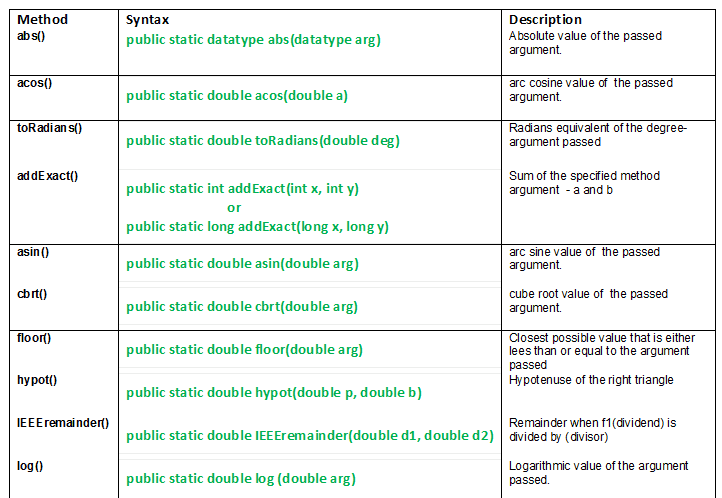JAVA数学课及其方法|集1  JAVA本文讨论的数学类方法:
JAVA本文讨论的数学类方法:
null
- abs(): JAVA数学abs() 方法返回传递的任何类型参数的绝对值。此方法可以处理所有数据类型。
- 特殊情况:
- 如果参数为正零或负零,则结果为正零。
- 如果参数为无穷大,则结果为正无穷大。
- 如果传递的参数为NaN,则结果为NaN。
语法:
public static datatype abs(datatype arg) Parameters: arg - the argument whose absolute value we need Returns: absolute value of the passed argument.
- acos(): JAVA数学acos() 方法返回传递参数的弧余弦值。 弧余弦是所传递参数的反余弦。 acos(arg)=cos -1 精氨酸 特殊情况: 如果参数为NaN或其绝对值大于1,则结果为NaN。 语法:
public static double acos(double a) Parameters: a - the argument whose arc cosine value we need. argument is taken as radian Returns: arc cosine value of the argument. - 托拉迪亚斯(): JAVA数学托拉第安(双度) 方法将参数(度)转换为弧度。 特别点: 数学课通常把弧度作为输入,这在实际应用中非常不同,因为角度通常以度表示。 语法:
public static double toRadians(double deg) Parameters: deg - degree angle needs to be in radian. Returns: radians equivalent of the degree-argument passed.
什么是争论? 一个常数,包含一个double类型的Not-A-Number(NaN)值。它相当于Double返回的值。longBitsToDouble(0x7FF80000000000L)。
解释数学类中abs()、acos()和toRadians()方法的Java代码。
// Java program explaining Math class methods// abs(), acos(), toRadians()importjava.math.*;publicclassNewClass{publicstaticvoidmain(String[] args){// Declaring the variablesintVali = -1;floatValf = .5f;// Printing the valuesSystem.out.println("Initial value of int : "+Vali);System.out.println("Initial value of int : "+Valf);// Use of .abs() method to get the absoluteValueintAbsi = Math.abs(Vali);floatAbsf = Math.abs(Valf);System.out.println("Absolute value of int : "+Absi);System.out.println("Absolute value of int : "+Absf);System.out.println("");// Use of acos() method// Value greater than 1, so passing NaNdoubleAcosi = Math.acos(60);System.out.println("acos value of Acosi : "+Acosi);doublex = Math.PI;// Use of toRadian() methodx = Math.toRadians(x);doubleAcosj = Math.acos(x);System.out.println("acos value of Acosj : "+Acosj);}}输出:
Initial value of int : -1 Initial value of int : 0.5 Absolute value of int : 1 Absolute value of int : 0.5 acos value of Acosi : NaN acos value of Acosj : 1.5159376794536454
- addExact(): JAVA数学加法器(整数a,整数b) 方法返回传递的参数之和。 特别点: 如果结果溢出int或long(根据传递的参数),该方法将抛出算术异常。 语法:
public static int addExact(int x, int y) or public static long addExact(long x, long y) Parameters: a - first value b - second value Returns: Sum of the specified method arguments - a and b. - asin(): JAVA数学asin() 方法返回传递的方法参数的arc sine值。返回角度在-pi/2到pi/2的范围内。 arc sine是所传递参数的反正弦。 asin(arg)=正弦 -1 精氨酸 特殊情况:
- 如果参数为NaN或其绝对值大于1,则结果为NaN。
- 如果参数为零,则结果为零。
语法:
public static double asin(double arg) Parameters: arg - argument passed. Returns: arc sine of the argument passed.
- cbrt(): JAVA数学cbrt() 方法返回传递的参数的立方根。 特别点:
- 如果参数为NaN,则结果为NaN。
- 如果参数为无穷大,则结果为与参数符号相同的无穷大。
- 如果参数为零,则结果为零。
语法:
public static double cbrt(double arg) Parameters: arg - argument passed. Returns: cube root of the argument passed
解释数学类中addExact()、asin()、cbrt()方法的Java代码。
// Java program explaining Math class methods// addExact(), asin(), cbrt()importjava.math.*;publicclassNewClass{publicstaticvoidmain(String[] args){inta =1, b =8;// get the result of addExact methodintradd = Math.addExact(a,b);System.out.println("Using addExact() : "+radd);System.out.println("");// Use of acos() method// Value greater than 1, so passing NaNdoubleAsini = Math.asin(radd);System.out.println("asin value of Asini : "+Asini);doublex = Math.PI;// Use of toRadian() methodx = Math.toRadians(x);doubleAsinj = Math.asin(x);System.out.println("asin value of Asinj : "+Asinj);System.out.println("");// Use of cbrt() methoddoublecbrtval = Math.cbrt(216);System.out.println("cube root : "+cbrtval);}}输出:
Using addExact() : 9 acos value of Asini : NaN acos value of Asinj : 0.054858647341251204 cube root : 6.0
- 地板(): JAVA数学楼层() 方法返回参数的下限值,即小于或等于传递参数的最接近整数值。 101.23的下限值为101 要点: 如果传递了NaN或无限参数,则会产生相同的参数。
Syntax: public static double floor(double arg) Parameters: arg - the argument whose floor value we need Returns:closest possible value that is either less than or equal to the argument passed - hypot(): JAVA数学低血压(双p,双b) 方法将三角形的底面和垂直面作为参数传递时,返回直角三角形的斜边。 斜边=[垂直] 2. +基地 2. ] 1/2
要点:
- 如果其中一个参数是无限的,那么结果就是正无穷大。
- 如果任何一个参数都是NaN,并且两个参数都不是无限的,那么结果就是NaN。
Syntax: public static double hypot(double p, double b) Parameters: p - perpendicular of the right triangle b - base of the right triangle Returns: hypotenuse of the right triangle
- IEEEremainder(): JAVA数学IEEERemainder(双d1,双d2) 方法通过对两个参数w.r.t IEEE 754标准应用余数运算来返回余数值。 剩余值= d1–d2*n 哪里 n=d1/d2的最接近精确值
Syntax: public static double IEEEremainder(double d1,double d2) Parameters: d1 - dividend d2 - divisor Returns: remainder when f1(dividend) is divided by(divisor)
- log(): JAVA数学日志() 方法返回所传递参数的对数值。
Syntax: public static double log(double arg) Parameters: arg - argument passed. Returns: logarithmic value of the argument passed.
解释数学类中floor()、hypot()、IEEEremainder()和log()方法的Java代码。
// Java program explaining MATH class methods// floor(), hypot(), IEEEremainder(), log()importjava.lang.*;publicclassNewClass{publicstaticvoidmain(String[] args){// Use of floor methoddoublef1 =30.56, f2 = -56.34;f1 =Math.floor(f1);System.out.println("Floor value of f1 : "+f1);f2 =Math.floor(f2);System.out.println("Floor value of f2 : "+f2);System.out.println("");// Use of hypot() methoddoublep =12, b = -5;doubleh = Math.hypot(p, b);System.out.println("Hypotenuse : "+h);System.out.println("");// Use of IEEEremainder() methoddoubled1 =105, d2 =2;doubler = Math.IEEEremainder(d1,d2);System.out.println("Remainder : "+r);System.out.println("");// Use of log() methoddoublel =10;l = Math.log(l);System.out.println("Log value of 10 : "+l);}}输出:
Floor value of f1 : 30.0 Floor value of f2 : -57.0 Hypotenuse : 13.0 Remainder : 1.0 Log value of 10 : 2.302585092994046
本文由 莫希特·古普塔 .如果你喜欢GeekSforgek,并想贡献自己的力量,你也可以使用 贡献极客。组织 或者把你的文章寄到contribute@geeksforgeeks.org.看到你的文章出现在Geeksforgeks主页上,并帮助其他极客。
如果您发现任何不正确的地方,或者您想分享有关上述主题的更多信息,请写下评论。
© 版权声明
文章版权归作者所有,未经允许请勿转载。
THE END


![关于”PostgreSQL错误:关系[表]不存在“问题的原因和解决方案-yiteyi-C++库](https://www.yiteyi.com/wp-content/themes/zibll/img/thumbnail.svg)



